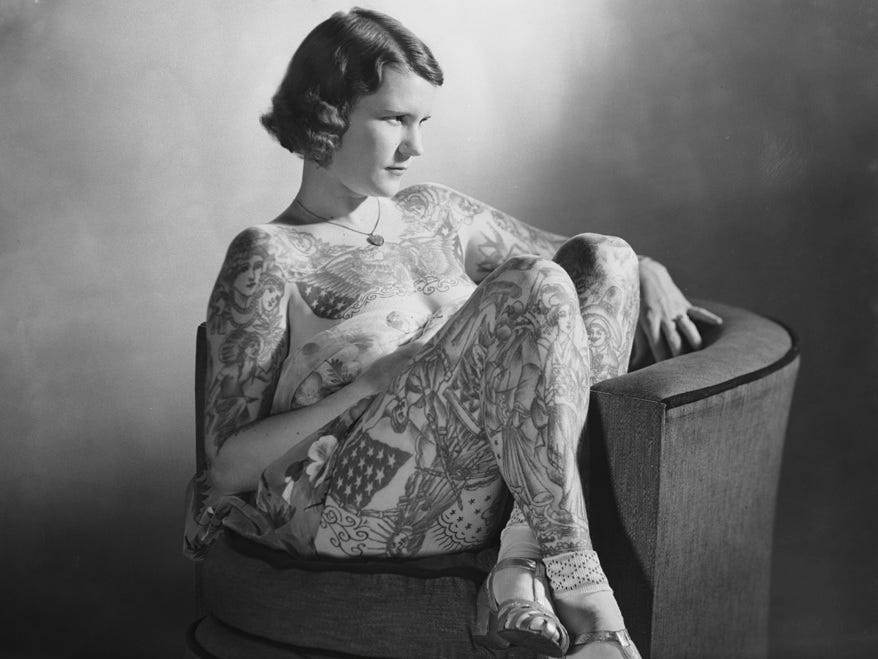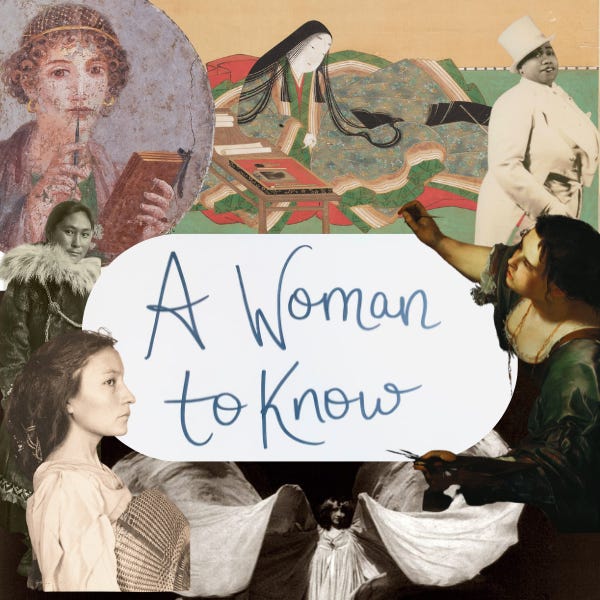A Woman to Know profiles once-forgotten women from history. To support this work, become a paid subscriber. You’ll get access to the subscriber-exclusive Friday editions, but you’ll also be able to read the entire back catalogue — that’s nearly 10 years of women to know!
Wanna get in touch? Reply to this newsletter.

In 1927, Betty Broadbent got her first tattoo. A decade later, her body was inked with more than 500 designs.
Betty grew up in Philadelphia but left the city in 1923, when she was just 14. She found work nannying and riding horses in a rodeo, but a weekend trip to Atlantic City changed the course of her career forever. On a night off, Betty wandered the famous boardwalk, where she met Jack Red Cloud, a circus performer billed as “The Tattooed Man.” Betty befriended Jack, who in turn introduced her to his trusted tattoo artist, New York City’s Charlie Wagner.
Betty pooled her life savings together and handed it over to Charlie and his partner, Joe Van Hart. She told them she wanted them to tattoo her in a neck-to-ankles “body suit.” The entirety of the work took nearly two years, after which Betty continued adding to the design with one-off tattoos from other artists.

In 1927, Charlie connected Betty to his friend Clyde Ingalls, who managed the Ringling Brothers and Barnum & Bailey Circuses. Betty traveled the world, performing in the sideshow attraction as “The Tattooed Lady,” “The Lady Who’s Different” and finally as “The Tattooed Venus.”
In 1937, Betty participated in the World’s Fair’s televised Beauty Pageant, shocking audiences with her full-body ink. She didn’t win the top prize, but in Betty’s eyes, she won something even more valuable: air time. The publicity did wonders for her career, and as Betty toured the world with the fair, she became one of the most photographed women in the world.
In 1939, a reporter from The New York Times visited Betty at the World of Tomorrow fair. Betty was performing there as “The Tattooed Lady” on display in the sideshow attraction. The reporter carefully documented Betty’s (literal) body of work:
Betty Broadbent, the tattooed girl in the show “Strange As It Seems” displayed most of her 565 designs at a preview yesterday. George Washington, who inspired the world of tomorrow, is on her left leg, above the calf; Colonel and Mrs. Lindbergh on her right leg; Brunhilde on the right shin and Pancho Villa on the left. On her right thigh Miss Broadbent has a picture of Dolly Forsythe, the girl who taught her trick riding fifteen years ago at Revere Beach in Boston …
The spread eagle that stretches from one shoulder to another is Miss Broadbent’s particular pride. It took six sittings, was started by an artist on the Bowery and was finished by another man in St. Louis, all over a period of seven months. “It hurt something awful,” Miss Broadbent confided, “but it was worth it.”
Betty performed with Clyde’s circus for the next 30 years, teaching herself to tattoo other people along the way. She retired from the circus life in 1967, at the age of 58, and set up her own tattoo shop in Florida.
In August 1981, she became the first-ever person inducted into the Tattoo Hall of Fame. She died just two years later.
More on 💘:
The Tattooed Lady: A History, by Amelia Klem Osterud
Bodies of Subversion: A Secret History of Women and Tattoo, by Margot Mifflin
Our Bodies, Our Ink, The New York Times
A Secret History of Women and Tattoo, The New Yorker
Tattoo Ink: How It Got Under New York’s Skin, The New York Times
Shock of the old: 10 trailblazing and transgressive tattooed ladies, The Guardian
More from me:
I’m nearly 500 pages into Red Comet, Heather Clark’s Sylvia Plath biography. I remember reading this years ago, back when it first came out, but this time around I’m devouring every detail. Can’t recommend it enough!
Last week I published my first-ever story in The New York Times, all about the creative, messy world of junk journaling. This Thursday it’ll be in the print paper — pick up a copy!
I am loving my bestie Alex Laughlin’s newest podcast project: Try Hard. Episodes come out every other Monday! Don’t miss it.




Have you read Loving Sylvia Plath? It discussed a lot how the cult of Plath v. Hughes has affected how we see her. I wonder how the book your reading deals with that.